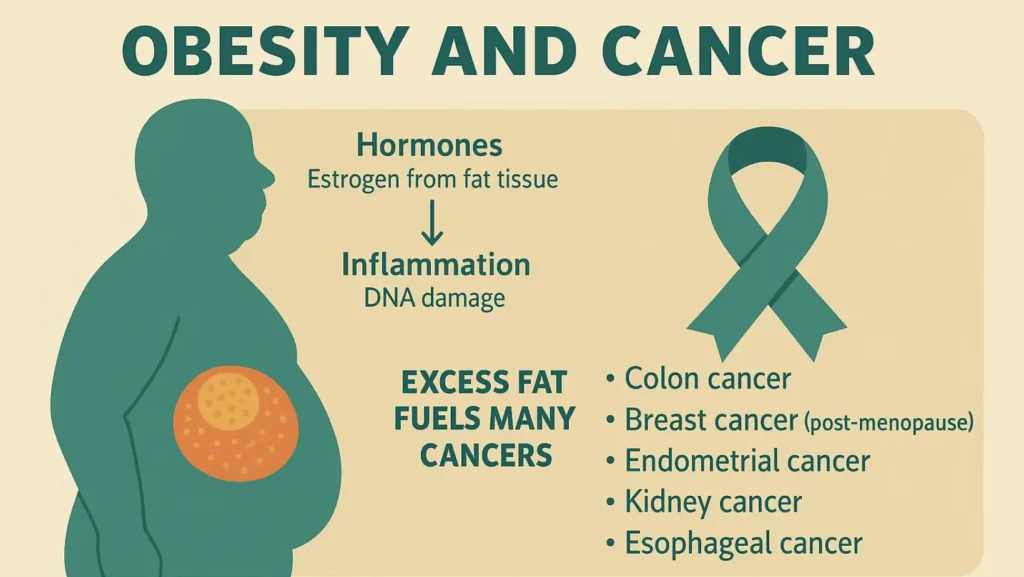The health risks of obesity are wide-ranging, serious, and often underestimated. When body fat goes beyond a healthy level, it places stress on nearly every system in the body. Doctors now recognize obesity as a chronic disease, not just a cosmetic concern. Beyond appearance, the real problem lies in how excess weight drives disease, weakens immunity, shortens life span, and lowers quality of life.
Table of Contents
ToggleThis article explores why obesity is considered a health risk, the main diseases caused by obesity, hidden complications, and practical steps to reduce risks.
Why Is Obesity Considered A Health Risk?
The human body works best with a balance between fat, muscle, and lean tissue. Fat itself is not harmful; in fact, it cushions organs, stores energy, and regulates hormones. But when fat cells expand beyond their safe limit, they start releasing harmful substances.
These fat cells produce inflammatory chemicals called cytokines. They disrupt insulin function, raise blood pressure, and damage blood vessels. Over time, this creates a storm of health problems. This is why experts often stress that obesity health risks extend far beyond appearance.
Doctors rely on Body Mass Index (BMI) to classify weight:
- A BMI of 18.5 to 24.9 is healthy.
- A BMI of 25 to 29.9 is overweight.
- A BMI of 30 or more is obesity.
But BMI has limits. For example, a muscular athlete may show a high BMI but not carry harmful fat. A more precise measure is waist size. A waistline above 40 inches in men and 35 inches in women suggests harmful belly fat. This fat, called visceral fat, wraps around organs and drives many medical complications of obesity.
Obesity is considered a health risk because it creates conditions like high blood pressure, high blood sugar, inflammation, and hormonal imbalances. These set the stage for deadly diseases.
Major Diseases Caused By Obesity
The list of diseases caused by obesity is long. Some strike quietly, while others show sudden, life-threatening symptoms. Here are the most significant ones:
Heart Disease And Stroke
One of the most feared obesity health risks is its close link to the heart. Extra fat increases LDL (“bad”) cholesterol and triglycerides while lowering HDL (“good”) cholesterol. Over time, fat buildup narrows arteries, a process called atherosclerosis. This makes obesity and heart disease strongly connected.
The same risk applies to stroke. High blood pressure, poor circulation, and narrowed vessels increase the chance of a clot cutting blood flow to the brain. Studies confirm that people with obesity are twice as likely to develop cardiovascular disease compared to those with normal weight.
Type 2 Diabetes
Excess fat leads to insulin resistance. This means cells no longer respond properly to insulin, the hormone that regulates sugar entry. As a result, blood sugar levels rise. Over time, this develops into type 2 diabetes.
This explains the strong link between obesity and diabetes. Once diabetes sets in, it raises the risk of blindness, kidney failure, nerve damage, and slow wound healing. In fact, nearly 80% of people with type 2 diabetes are overweight or obese.
Obesity And Cancer
The link between obesity and cancer is not always obvious. Yet researchers show that excess fat fuels many cancers. Hormones such as estrogen, produced in fat tissue, encourage abnormal cell growth. Chronic inflammation from fat also damages DNA, making cancer more likely.
Cancers with strong ties to obesity include:
- Colon cancer
- Breast cancer (post-menopause)
- Endometrial cancer
- Kidney cancer
- Esophageal cancer
This is why experts now list obesity alongside smoking as one of the top cancer risk factors.
Gallbladder Disease
The gallbladder stores bile, which helps digest fat. In people with obesity, bile often becomes rich in cholesterol, leading to stones. These stones block the bile duct, causing sharp abdominal pain, nausea, and infection. This makes gallbladder disease and gallstones common in people with obesity.
Arthritis And Joint Problems
Carrying excess weight is like wearing a heavy backpack all day. Knees, hips, and lower back joints suffer the most. Over time, cartilage that cushions joints wears down, leading to osteoarthritis.
This link between obesity and joint pain and osteoarthritis is well documented. Even modest weight loss can ease pressure. For instance, every extra 10 pounds adds nearly 30–40 pounds of pressure on the knees while walking.
Gout
Gout is a painful arthritis caused by excess uric acid crystals building in joints. Obesity raises uric acid levels, making gout flares more likely. Reducing excess weight and limiting alcohol intake are two effective steps against gout.
Sleep Apnea And Breathing Issues
Obstructive sleep apnea (OSA) is another serious problem. Fat deposits around the neck and throat block airflow during sleep. People stop breathing for seconds, sometimes hundreds of times a night. This lowers oxygen, strains the heart, and causes daytime fatigue. Left untreated, OSA increases risks of heart disease and stroke.
Other Medical Complications Of Obesity
The list does not stop with the diseases above. Other medical complications of obesity include:
- Liver disease (NAFLD): Fatty liver is now the most common liver problem worldwide. It can progress to cirrhosis or liver failure.
- High blood pressure: Extra weight raises blood volume and pressure on vessel walls. This damages arteries over time.
- High cholesterol: Obesity often raises LDL cholesterol while lowering HDL.
- Reduced life expectancy: Studies show obesity can shorten life by 5–10 years.
- Menstrual and fertility issues: In women, excess fat disrupts hormones and may cause infertility.
- Mental health concerns: Stigma, low self-esteem, and depression are common companions.
How Weight Triggers These Problems
To understand obesity’s damage, think of fat as an organ that produces chemicals. In healthy levels, it helps regulate energy. In excess, it turns toxic.
Key mechanisms include:
- Chronic inflammation: Fat cells release cytokines that damage tissues.
- Hormonal imbalance: Fat tissue increases estrogen and other hormones.
- Insulin resistance: Leads directly to diabetes.
- Blood vessel damage: Increases the risk of heart attack and stroke.
This is why many conditions such as cardiovascular disease, diabetes, and certain cancers appear together.
Reducing Your Risk And Protecting Your Health
The good news is that even modest weight loss improves health. A 5–10% reduction in weight lowers blood pressure, improves cholesterol, and cuts diabetes risk.
Practical Steps That Work
- Weight loss through diet: Focus on whole foods, fruits, vegetables, lean protein, and fewer sugary drinks.
- Physical activity / Exercise: Aim for at least 150 minutes of moderate activity per week. Even walking helps.
- Better sleep: Poor sleep raises hunger hormones. 7–9 hours is ideal.
- Limit alcohol: It adds calories and raises uric acid, worsening gout.
- Quit smoking: Smoking plus obesity multiplies health risks.
- Medical help: Some need medication or surgery. Bariatric surgery often reduces long-term obesity health risks.
The Bottom Line
The health risks of obesity are real, wide-ranging, and dangerous. The most serious include obesity and heart disease, obesity and diabetes, and obesity and cancer. Others like gallbladder disease, arthritis, and sleep apnea may reduce daily quality of life.
The good news: even small changes reduce these risks. Start with lifestyle improvements, regular checkups, and if needed, medical treatments. The sooner you act, the lower the long-term obesity health risks become.
FAQs
Which health risk is associated with obesity?
Obesity increases the risk of heart disease, type 2 diabetes, some cancers, joint damage, and sleep apnea, all of which reduce lifespan if untreated.
What are 5 risk factors of obesity?
Poor diet, lack of exercise, genetics, hormonal imbalance, and certain medications all increase the risk of developing obesity and its health complications.
What is one health risk associated with obesity?
One major risk is type 2 diabetes. Extra fat drives insulin resistance, raising blood sugar and leading to lifelong complications if not controlled properly.
What are the three main health issues related to obesity?
The three main issues are heart disease, type 2 diabetes, and cancer. These conditions account for most deaths linked to obesity worldwide.
Who is most at risk for obesity?
People with sedentary lifestyles, poor diets, family history, hormonal problems, or those who are middle-aged or older face higher obesity risk.
What are the 5 A’s for obesity?
Ask, Assess, Advise, Agree, and Assist are steps doctors use when guiding patients through obesity treatment and long-term management.
What are 5 common health risk factors?
High blood pressure, high cholesterol, high blood sugar, smoking, and excess weight are the most common risk factors for chronic diseases.

This article is medically reviewed by Dr. Chandril Chugh, Board-Certified Neurologist, providing expert insights and reliable health information.
Dr. Chandril Chugh is a U.S.-trained neurologist with over a decade of experience. Known for his compassionate care, he specializes in treating neurological conditions such as migraines, epilepsy, and Parkinson’s disease. Dr. Chugh is highly regarded for his patient-centered approach and dedication to providing personalized care.









